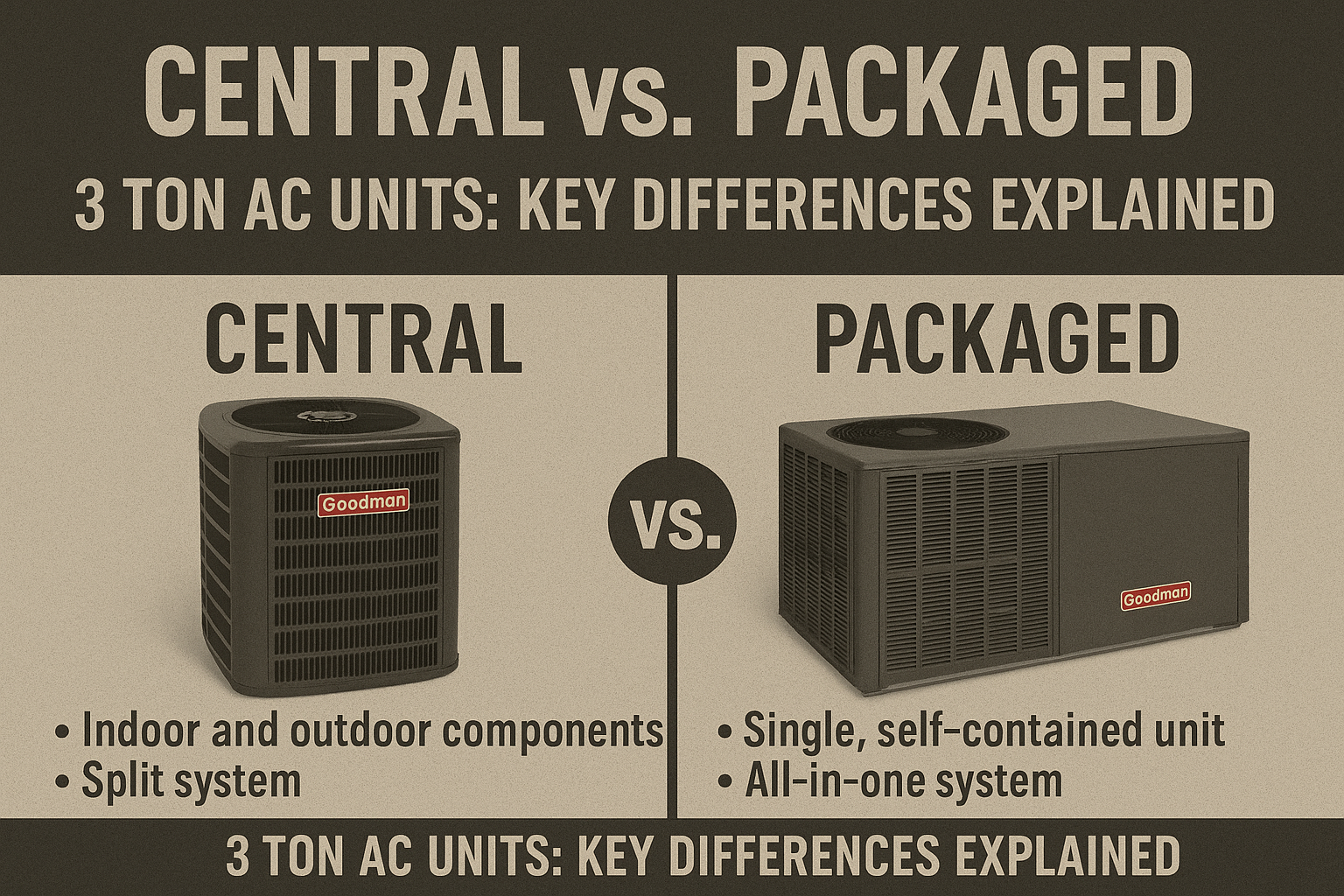When it comes to 3-ton air conditioners, homeowners often face a critical decision: should you opt for a central split system or a packaged unit? Both offer 36,000 BTUs of cooling capacity, but how they operate, install, and integrate into your home can differ significantly.
This guide will break down the major differences between central and packaged 3-ton AC units, helping you choose the right configuration for your home, climate, and lifestyle.
What Is a Central AC System?
A central (or split) air conditioning system consists of two main components:
-
Indoor Unit: Usually installed in a basement, attic, or utility closet. This includes the evaporator coil and air handler or furnace.
-
Outdoor Unit: Contains the condenser coil and compressor.
Refrigerant lines and electrical wiring connect these components. The system distributes cooled air through ductwork to all areas of the home.
Learn more about central air systems from Energy.gov’s air conditioning basics.
What Is a Packaged AC Unit?
A packaged air conditioner combines all key components—compressor, condenser, evaporator—into a single cabinet, typically installed on a concrete slab or rooftop.
These are more common in:
-
Mobile homes
-
Homes without basements or attics
-
Small commercial buildings
Packaged systems can be air conditioner-only or include heating components (gas or electric).
See Lennox’s guide to packaged units for examples and configurations.
Side-by-Side Comparison: Central vs Packaged
| Feature | Central AC System | Packaged AC Unit |
|---|---|---|
| Installation Location | Split (indoor & outdoor) | Single outdoor cabinet |
| Maintenance Access | More access points | Easier single-point access |
| Space Requirements | Needs indoor utility space | Saves indoor space |
| Aesthetics | Less visible outdoors | Larger, more prominent exterior unit |
| Efficiency Potential | Higher SEER options | Limited high-SEER availability |
| Customization | Greater flexibility (zoning, air flow) | Limited ducting options |
| Longevity | Generally longer life with maintenance | Slightly shorter lifespan |
| Cost | Higher upfront, better ROI | Lower upfront, moderate efficiency |
When to Choose a Central AC
Opt for a 3-ton central system if:
-
Your home has existing ductwork
-
You want zoning control and customizable comfort
-
You prioritize energy efficiency and quiet operation
-
You have space for both indoor and outdoor components
When a Packaged Unit Makes More Sense
Choose a 3-ton packaged unit if:
-
Your home lacks indoor installation space
-
You need a compact, all-in-one solution
-
You're replacing an existing rooftop or slab-mounted system
-
You want easier servicing and faster installation
Packaged units are popular in retrofits and mild climates where ductwork challenges exist.
Efficiency and SEER Ratings
Central systems often support higher SEER ratings due to component separation and advanced design. However, some packaged units now offer competitive SEER2 options in the 14-17 range.
Check the AHRI Directory to compare certified efficiency ratings across brands and models.
Noise Levels and Indoor Comfort
Central systems are usually quieter indoors, as the noisiest components are outside. Packaged units, depending on placement, may transmit more noise into living spaces, especially if mounted on the roof.
If noise is a concern, check decibel ratings before purchase.
Cost Considerations
-
Central AC: $3,500–$7,500 installed
-
Packaged AC: $2,500–$5,500 installed
While packaged units can be cheaper upfront, central systems often offer better long-term performance and lower utility bills due to better efficiency.
Conclusion: Which Is Right for You?
Choosing between a central and a packaged 3-ton AC depends on your home layout, existing infrastructure, budget, and preferences. Central systems offer superior customization and efficiency, while packaged units are ideal for tight spaces and quick installs.
Still unsure? Compare models in our 3 Ton AC Units Collection or reach out to our team for personalized guidance. We’ll help you determine the best fit for your comfort and home design.







